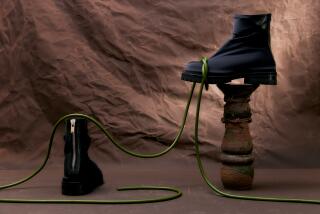Men’s luxury watches go stealth
- Share via
Even as consumers slowly climb out of the economic morass of the last few years, the men’s luxury watch business — in which a single timepiece can easily sell for five figures or more — is still responding to the turmoil, emphasizing a kind of stealth luxury, a return to classic styles and the notion of brand heritage.
Luxury fashion cycles through trends at lightning pace every six months. But the complicated, technical nature of timepieces — which can have as many as 700 moving parts — means changes in the watch market move at a comparatively glacial pace, taking from 11/2 to almost eight years.
One of the most noticeable manifestations of the low-key, don’t-look-too-flashy approach has been in color, according to retailers of the high-end horological devices who attended the annual international BaselWorld Watch and Jewellery Show in Switzerland this year.
“The most popular men’s trend we’re currently seeing is the black-on-black look,” said Josh Briest, co-owner of Philippe’s Watches of Beverly Hills. “What they call a kind of ‘phantom black’ look; watches with a black face, black casing and black straps.” Briest cited Chanel’s black ceramic J12 style and several styles from Panerai as popular examples of the current demand for the darker side.
Greg Simonian, president of luxury watch boutique Westime, which has two local branches, reports that an uptick in demand for black watches started a few years ago, and continues. “Awhile back we’d noticed there was a big demand for black watches in places like Panama, Mexico City and Brazil,” Simonian said. One theory is that the black timepieces looked less ostentatious than precious metal and gem-encrusted styles, and thus would be less likely to attract thieves.
But Simonian thinks the increased interest in black cases, black dials and black rubber watch straps in the U.S. “has less to do with getting mugged. I think it’s a way for [men] to be able to enjoy the luxury without being loud about it.”
Another approach to stealth luxury has been to go low profile — literally.
“In 2007 and 2008 it was all about the bold, flashy, gold watches,” said Cody Kondo, senior vice president and general merchandising manager of accessories at Saks Fifth Avenue. “Now we’re seeing a trend toward thinner watches that don’t serve as an indication of wealth.”
Kondo credits a shift in customer values. “We’re seeing less of an overt display of wealth,” he said. “And more of an appreciation for the craftsmanship and design of luxury watches.”
That’s why you’ll see a Swiss luxury brand like Piaget trumpeting the fact that its new Altiplano Automatic 43mm (the number traditionally refers to the diameter of the watch face) is a mere 5.25 millimeters thick, making it “the thinnest watch in its category,” and touts its new Calibre 1200P movement (the movement is the actual mechanism, or guts, of a watch) as being “the thinnest self-winding movement currently on the market, at 2.35mm.” By comparison, on the 44-mm Panerai watch, the crystal covering the face alone clocks in at 2mm.
Westime’s Simonian said that although he’s noticed a move to smaller and thinner timepieces — at least on the manufacturing side — he’s waiting to see that translate into real customer demand.
“I’ve seen a lot of that, but I’m not sure if it’s going to take off,” Simonian said. “I have the feeling that many of the watch companies have done that because [smaller and thinner watches are] what’s more popular in China and Asian markets. And it seems like every year [people] talk about how this is going to be the last year for big watches — and it’s been maybe eight or nine years now. Big watches are here to stay.”
Briest at Philippe’s says he’s noticed that current demand for men’s watches is moving in the opposite direction — thanks to women. The oversized chunky gold watch is particularly popular with women right now, he said, and “as more women start to wear the 36mm Rolex Datejust watch, one that has traditionally been considered a man’s watch, men have responded by moving upward to the Rolex Datejust II 41mm case size, and watches that are even larger.”
On a recent tour of Tourneau’s multi-level Manhattan temple of timepieces on 57th Street, Tourneau’s executive vice president Andrew Block shared some insight into the purchasing habits of the luxury watch buyer.
“People take about three months from the time they start looking at watches to the time they finally buy one,” Block said. “It’s not something they take lightly.
“And in this economy, brands — especially the ones that are celebrating anniversaries like Chopard and Tag Heuer who are [both] marking their 150th — have started really emphasizing their heritage as a way of communicating that it’s a safe purchase and a worthwhile investment.”
Saks’ Kondo concurs: “We’ve definitely seen a trend in luxury watchmakers emphasizing their heritage and history, more so than usual,” he said. “Given the current state of the economy, brands have been forced to reevaluate their value proposition and prove their worth by communicating their heritage and craftsmanship to the customer.” He noted that men, specifically, respond to the emphasis on history.
Which is why Swiss brand Tag Heuer is marking its 150th anniversary with the $80,000 limited-edition platinum Monaco V4. In addition to a symbolic run of only 150 pieces, it boasts the first belt-driven movement and micro ball bearings — a design inspired by sports car engines and a direct nod to the company’s motorsporting heritage. (True timepiece aficionados will be quick to point out that the square-faced Monaco watch is the same Tag Heuer style Steve McQueen wore in the movie “Le Mans.”)
As trends in the men’s luxury watch business begin to reflect economic reality, what about the notion that the wristwatch itself — no matter if it’s the skull-cracking kind that costs more than a condo in Boca Raton, Fla. — is headed the way of the dodo because of the proliferation of iPhones, BlackBerrys and ubiquitous timestamps in the corners of computer screens?
“If somebody wants to tell time, it’s all around us,” Tourneau’s Block says. “People don’t buy these watches to tell time, they’re making a statement. It’s like wearing cufflinks.”
Make that very expensive cufflinks.







